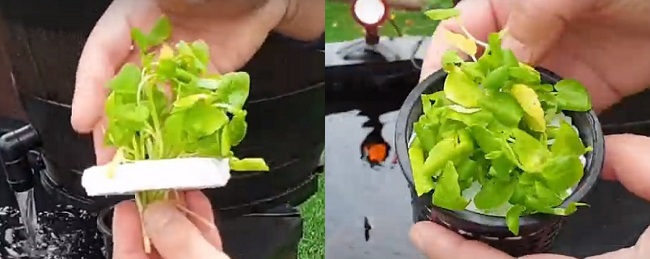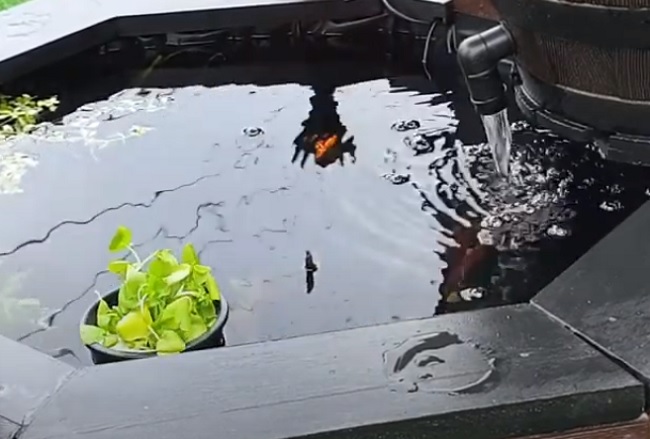How to grow Watercress in a Pond in Pot:
Watercress is a dark green leafy plant & it was discovered during the era of Greeks, Romans & Persians who utilized this plant to cure Patients suffering from insanity, as a drug & as a breath freshener.
Origin of Watercress:
Watercress is referred to as the
food for poor people in England. During early 1800s, sandwiches of the plant
were a breakfast of the working class family. The plant was brought to US in
mid 1800s, & it is now considered a renowned food for North American citizens.
People in China & Vietnam add this plant to soups & stir fries.
Watercress plant is native to
western Asia but it has been grown in Europe, USA & Asia. The name of the
plant means water which implies that watercress is cultivated in water.
People in Europe & North
America use sandwiches made of watercress or they use this plant in various
other recipes including omelets, potato salads, as cottage cheese spread, or as
garnishes in soup & scrambled eggs. French people use it in fines herbs,
several white sauces, while people in Asia cook them. It is known as a renowned
crop in Asia, where it is used in stir-fries & soups.
This plant helps in fitness too
because it is used for bronchial disorders & for enhancing stamina. Persian
soldiers ate this plant for avoiding or curing scurvy. It is used in tea for
treatment of aches, pains & migraines. Nutritionists use this plant as a
superfood because it carries lots of antioxidans. This plant offers Vitamin A,
B6, C, E, K, beta carotene, iron, folic acid & calcium. It can protect body
against cancer.
Other Names of Watercress:
In different countries watercress
has different names:
jhri godem (Armenia), barbeen
(Arab), waterkers (Dutch), sai yeung choi (Cantonese), tazer alaf shesmeh
(Persia), cresson de fontaine (France), isovesi krasi (Finnish), brunnenkresse
(Germany), garga hanazir (Hebrew), selada air/ayer (Indonesia, & Malaysia),
nerokardamo (Greek), votakuresu (Japan), shui jee cai (Mandarin), vaistino
rezuiko (Lithuanian), bronnkarse (Norway), kress vodianoj (Russia), agriao
(Portugal), vodna kresa (Slovenia), kallfrane (Sweden), berro di agua/crenchas
(Spain), lampaka (Tagalog), su teresi (Turkey), phakat nam (Thai), & cai
soong.
Growing watercress in aquarium / pond
Scientific Names of Watercress:
Scientific names of Watercress are
as follows:
Nasturtium officinale Garden cress: Lepidium sativum Family: Brassicaceae
(cabbage family).
Grow Watercress in Pond:
Get a cutting from an adult
Watercress plant. The simplest way to take watercress cuttings is from grocery.
Either you purchase watercress cutting from a display or receive bagged
cuttings, this plant has the natural tendency of re-growing. The best cutting
would be the one that have growing roots. This way you can put cutting of
watercress in your pond quickly than the one that haven’t produced roots.
Watercress regrows in around 3
weeks before you put the plant in pond. Choose the cutting that are darker
green with a bright, complete leaf at the top. The cutting that has longer
stems are a bit simpler to grow in pots.
Add watercress to a netted pot instead of adding it to pond. Cut a foam in round & make a hole in the center.
I bought watercress from a store and cut stems. I put those cuttings inside the pot with a foam. Make sure the hole is big enough so that there is enough space for the plant to grow. As watercress grow, it get a thick stem so do not make a very small hole in foam.
Add watercress plant to the center of the foam so that it fits well inside & put pot in water which will float on water surface.
Also you can purchase a cutting
from a nursery. If you can’t find cuttings, then you can use an adult plant or
seeds. Move them to your pond without getting cuttings.
Watercress grows fast & soon you will need bigger pot. I am using a big pot with more space & I have added clay to it. I have rinsed the pot & clay to remove dirt.
Watercress is removed form small pot gently so that it does not hurt the plant roots. I have added the plant to a new big pot for better growth.
Watch video about growing watercress in a pond which shows every step in detail:
How to grow watercress in a pond?
There is another choice of
getting watercress cuttings from a grown up plant such as remove a leafy branch
from watercress’ main stem.
Submerge the plant in a pot that
is filled with warm water. Drop the complete cutting in a cup of water. The
cutting will float on the surface of water, & you can leave it there. If
you wish to grow multiple cuttings, then it would easier if you spread them out
so they are not placed on top of one another. You can put each cutting in a
separate pot to allow it to raise on its own. Also you can place multiple
cuttings in a bigger container such as a bucket, without any issue.
Make sure the plant continues
growing, keep the container in a place not affected by harsh weather & in ample
sunlight. The plant can grow well in temperatures of over 10 degrees Celsius.
The water gets motionless over
time, so put the cuttings in pots. Then put the pot in a container filled with
fresh water.
If you plot watercress cutting in
warm water, then it is possible to drop the cuttings directly in the pond. They
will grow fresh roots & settle in the pond on its own.
It will take around one week for
the roots to start growing. Observe the cutting & soon if everything goes
right you will see the strands forming close to the bottom of the stem. They
originate from where you have cut the branch from the grown up plant stem. You
can watch them after a few days. Once you see them, then it is time to
transplant the cutting to the pond.
If you have not observed any
roots growing, you can wait for some more time. Make sure you change the water
after every 2 or 3 days for keeping it fresh. If this method does not work for
you, then start the process again with a fresh cutting.
Use netted pots because it is
easier to put this pot later in your pond. Put every watercress cutting in a
separate pot.
Think about long term before you
actually put your plant in a pot. If size of the pot is large then it is good.
We would recommend a pot of size 3 inches. We did not put any gravel or soil in
the pot & it is a lot easier to grow watercress this way.
Stick the cutting into holes dug
into the pots. Shift aside some of the cultivating medium in the center of
every pot. Dig a hole that is large & you can bury watercress’ roots.
Ensure that the leaves of the plant are above the growing medium but they are
not touching it, or otherwise they will rot. Then shift the pots into
containers filled with fresh water to keep the plant medium moist.
Submerge the pots in fresh water
but ensure the water level does not overflow it, or else it is possible that it
could wash out the plant.
The cutting likely would not be
able to stay upright. Lay it down, keeping the roots of cutting in the growing
medium.
It is recommended to place the
plant in sunny region. The best temperature for the plant is between 10 – 16
degree Celsius. Change water every 2 or 3 days to ensure that the growing
medium remains moist.
If you are planning to keep the
plant in a warm region, then inspect the growing medium. However, if the heat
is high & sunlight is too bright then plant will dry out.
Let the cutting stay in the pot
for about a week & then transplant it to your pond. The roots of the plant
will sprout & fresh leaves will start to form.
Propagate Watercress:
This plant can be propagated from
cutting or sowing seed. If you want to grow it through latter method, then it
is recommended to sow seed below soil surface, about 1 / 4 inches, 3 weeks
earlier than the last frost free date in your area. Keep the soil moist or it
won’t grow. If conditions are ideal, b/w 10 to 16 Degree-Celsius, & soil is
wet, then watercress will grow. There should be a space of 8 inches between
every plant when transplanting & keep them in a sunny area.
Watercress Care & Maintenance:
It is very easy to care for this
plant, if watercress is kept wet. They do not require high nutrition, although
it may have deficiency of potassium, phosphorus or iron. Deficiency of
phosphate can result in stunted & dark color foliage while deficiency of
potassium is reflected in scorching on older leaves. Watercress may turn yellow
in winter due to deficiency of iron. To fight such deficiencies, mix a
fertilizer which is soluble in water according to the recommended rates. Few insects
including whitefly, snails & spider mites can hurt your plant. Leaves of
the plant can be harvested throughout the year. Feel the best flavor during
winters while its flavor is reduced once watercress has flowered or
temperatures increase over 30-degree Celsius. You can harvest watercress by
cutting it back to four inches & then the plant can re-grow. The leaves of
watercress can be kept in refrigerator for about a week but for medical or
culinary purposes use them quickly.
Watercress is a simple & beautiful
addition to the pond. It is a good idea to cultivate them in pots. Keep the
roots below level of water. Change water after one or two times a week. This
plant can live healthy even in harsh weather conditions but the best pH range
is 6.5 to 7.5.
The root system of watercress can
absorb nutrients from surrounding. Fish waste can be used as nutrition for the
plant & there is no need of additional fertilizers.
If you want to introduce watercress
to aquarium, then it can help you build an ecosystem. However, it is
recommended to change up to 50 percent every week if you want to keep clean
water. Add fish that can live in harsh conditions of no filter, & no
heater. Make sure you trim watercress so that it can grow healthy leaves.
Watercress can clean your aquarium so there won’t be any need of adding a filter.
Also if your tank size is larger, then it is a bonus for maintaining an ecosystem
because it reduces maintenance & provide adequate space for plant &
fish to thrive.
Pros & Cons of Watercress in a Pond:
Watercress can absorb nutrients
from water which helps the plant to grow healthy & remove the fish waste.
Food waste when decomposes releases toxic ammonia. Watercress breaks down the
harmful ammonia into nitrites which is still harmful. Watercress further
decomposes nitrites into less toxic nitrates which can be removed from water.
Hence watercress can act as a natural filter in your aquarium. It helps clean
water, & looks clean & beautiful in a fancy aquarium.
The major cons of watercress in pond
is that it needs patience. Wait till watercress is grown up. Wait till the
chemistry of water gets balanced. Sometimes you need to wait for a longer
period of time. If you can’t wait & looking for shortcut, then my advice is
that do not introduce watercress to your pond.
Trimming is a process to give
plant a shape when they are overly grown up or have dead leaves. Old leaves of
watercress need to be trimmed & the plant needs maintenance if you want
healthy leaf system. Hence adding watercress to a pond needs maintenance. Potassium,
phosphorus or iron deficiencies can affect health of your plant.
Popularity of Watercress in Australia & New Zealand:
People in Australia loves to eat
healthy food. They are also looking for good taste & vegetables that can
offer big advantages. Watercress is very popular in other parts of the world
but it is available in limited varieties in Australia. In Australia, people
love to eat watercress & other cress in salad mixes.
Kowhitiwhiti or watercress is
cultivated on the brink of rivers & creeks around New Zealand. People of
the area can eat them raw or cooked, it has a mild mustard flavor.










My first and final stop looking for growing watercress in a pond. Thank you for detail article and photos.
ReplyDeleteThank you Yakop
ReplyDeletePost a Comment